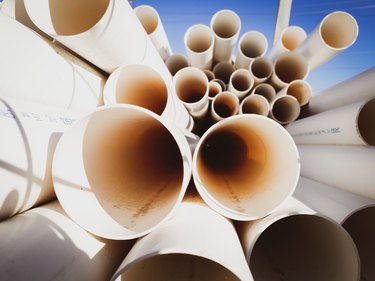
While PVC is a valuable material for home piping, it does degrade with prolonged exposure to sunlight. If you'll be using PVC plumbing pipe outdoors where it will be exposed to sunlight, it's important to provide protection. The most effective way to create a UV-protected PVC pipe is to paint it.
Why PVC Pipe Protection Is Necessary
Video of the Day
All objects left out in the sun are exposed to visible and nonvisible radiation. Nonvisible radiation includes UV (ultraviolet) light. PVC pipe is affected by UV light, which degrades the material over time. PVC pipe exposed to sunlight has been shown to discolor, becoming yellow and eventually brown or black, while also losing its shine and displaying a chalky appearance.
Video of the Day
Even more problematic is the fact that PVC pipe exposed to sunlight can lose impact resistance after two years. This refers to the material's ability to sustain and withstand blows. Your outdoor PVC pipe must remain strong and able to stand up to impacts. While underground PVC pipe is protected from sunlight, aboveground piping isn't. For this reason, it's important to paint exposed PVC pipe to protect it.
Best Ways to Protect PVC Pipe
Given the fact that PVC pipe can potentially lose impact resistance after two years, it's a good idea to protect the pipe from the sun's UV rays. This can be done by covering the piping with a tarp or shielding it with an opaque surfacing agent.
An ideal way to protect PVC pipe is to paint it. Painting provides long-lasting protection and is easy to do. You'll want to use spray paint for plastic, which tends to repel things from sticking to the surface and offers protection from fading and cracking. Choose a light paint color, such as white or cream. Dark colors, like brown and black, tend to absorb more ultraviolet rays.
Things You'll Need
How to Protect PVC Pipe From UV
You'll be using chemicals to prime and paint the PVC pipe. For this reason, it's important to work in a well-ventilated area. Outdoors is preferable, but if you do work indoors, make sure there's good airflow.
Step 1: Clean the Pipe With Water
Start by cleaning off any debris on the pipe. Use a clean, wet rag to thoroughly wipe down all sides of the piping. Rinse the rag in water, as necessary, when cleaning.
Step 2: Prepare Pipe for Further Cleaning
PVC pipes are often coated with chemicals that can prevent paint from sticking to the surface. Applying an ammonia-based cleaner, such as window cleaner, will remove any substances that could prevent paint adhesion. Put on your reusable gloves, safety goggles, and respirator and spray the pipe with window cleaner; then wipe off with a rag.
Step 3: Scuff the Pipe
To ensure that the paint sticks once applied, it's important to scuff the surface of the PVC pipe prior to painting. Wrap a piece of 200- to 300-grit sandpaper around the pipe and pull the paper up and down to scuff the surface. Stop when the surface of the pipe is dull and no longer shiny.
Step 4: Clean off the Pipe
Use a wet rag or tack cloth to clean off shavings from sanding. Ensure that all particles are removed.
Step 5: Protect the Workspace for Painting
Protect the work area with a large piece of cardboard or a drop cloth. Ensure that the cardboard or drop cloth is large enough to catch any overspray.
Step 6: Spray Paint the Pipe
Carefully spray paint the pipe. Apply slowly with an up and down motion, creating a thin coat, so there is no dripping. If working on a flat surface, do one side and allow it to dry before turning the pipe over to do the other side. One layer of paint will provide adequate protection from UV exposure, but two coats offer even more protection. If you decide to apply another coat, let the first coat dry thoroughly before applying more paint.